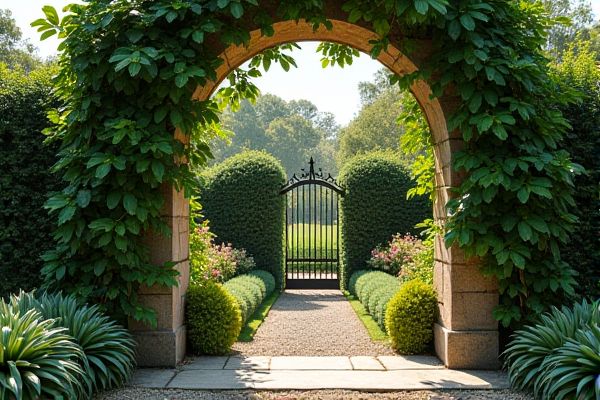
A garden arch serves as an elegant decorative entryway that can support climbing plants and enhance the aesthetic appeal of your outdoor space, while a garden gate functions primarily as a practical barrier providing security and defining property boundaries. Discover the key differences and how each element can transform your garden by reading the full article.
Table of Comparison
| Feature | Garden Arch | Garden Gate |
|---|---|---|
| Purpose | Decorative entryway, supports climbing plants | Secure entry, controls access |
| Material | Wood, metal, vinyl | Wood, metal, wrought iron |
| Functionality | Enhances garden aesthetics | Provides security and privacy |
| Installation | Simple, often standalone | Requires hinges and latch, embedded posts |
| Size | Tall, wide enough for walking | Varies, sized for passage control |
| Cost | Typically lower | Usually higher due to hardware |
Introduction to Garden Arches and Garden Gates
Garden arches create elegant vertical accents that define entryways and add visual interest to your outdoor space. Garden gates serve as functional barriers, providing security and controlled access while complementing the landscape design. Both features enhance garden aesthetics but differ in purpose, with arches emphasizing decoration and gates focusing on boundary and protection.
Defining the Purpose: Arch vs Gate
A garden arch primarily serves as an ornamental structure that enhances the aesthetic appeal and provides a decorative entry point to your outdoor space. In contrast, a garden gate functions as a secure barrier that controls access, ensuring privacy and protection for your garden area. Understanding these distinct purposes helps in choosing the right feature that aligns with your landscape design and practical needs.
Aesthetic Appeal: Visual Impact of Arches and Gates
Garden arches create a graceful and inviting aesthetic, often serving as focal points that enhance vertical interest with their curved designs. Garden gates provide a strong visual boundary and can be customized with intricate patterns or materials to complement your landscape style. Both elements contribute significantly to the overall garden atmosphere by defining spaces and adding charm.
Material Choices and Durability
Garden arches are often crafted from wrought iron, cedar, or vinyl, providing a range of durability options depending on your climate and maintenance preferences. In contrast, garden gates typically utilize heavier materials like steel, hardwood, or aluminum to ensure enhanced security and longevity. Choosing the right material directly impacts the lifespan and resilience of your garden structure.
Installation and Space Requirements
Garden arches typically require less space and simpler installation, often involving anchoring into the ground with stakes or concrete for stability. Garden gates need a more substantial framework, including posts for hinges and a secured latch system, demanding more precise measurements and sturdier foundations. Both structures benefit from level ground, but gates generally necessitate a wider and more robust setup due to their functional purpose of providing access control.
Functionality: Access vs Decoration
A garden gate primarily serves the functionality of providing controlled access to a garden, enhancing security and defining entry points. In contrast, a garden arch mainly functions as a decorative element that adds visual interest and can support climbing plants without restricting passage. While gates emphasize practical access management, arches focus on aesthetic appeal and garden design enhancement.
Security Considerations
Garden gates provide a stronger security barrier compared to garden arches, as they can be locked and are typically constructed with solid materials to prevent unauthorized access. Garden arches serve primarily as decorative entryways and do not offer physical protection or control over entry. When security is a priority, installing a reinforced garden gate with durable locking mechanisms ensures better protection for the property.
Maintenance and Longevity
Garden arches typically require less maintenance than garden gates due to their simpler structure and fewer moving parts, reducing the risk of wear and tear over time. Materials such as powder-coated metal or treated wood can extend the longevity of both, but gates often need regular lubrication of hinges and occasional hardware replacement. Proper sealing and weatherproofing significantly enhance the durability of garden arches and gates exposed to outdoor elements.
Cost Comparison: Garden Arch vs Garden Gate
Garden arches generally cost less than garden gates due to their simpler design and materials, with typical prices ranging from $100 to $300, while garden gates often start around $200 and can exceed $1,000 depending on size and material quality. Installation costs for garden gates are usually higher because they require hinges, latches, and sometimes professional fitting, whereas garden arches often need minimal installation. Your choice between a garden arch and a gate will affect both your initial investment and potential maintenance expenses over time.
Choosing the Right Feature for Your Garden
Garden arches create an elegant vertical focal point that supports climbing plants, enhancing garden aesthetics and providing a welcoming entrance. Garden gates offer practical functionality by securing boundaries while complementing landscape design with various materials like wood, metal, or wrought iron. Selecting between a garden arch and gate depends on whether you prioritize decorative appeal or access control within your outdoor space.
 homyna.com
homyna.com